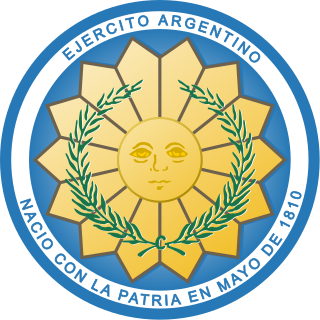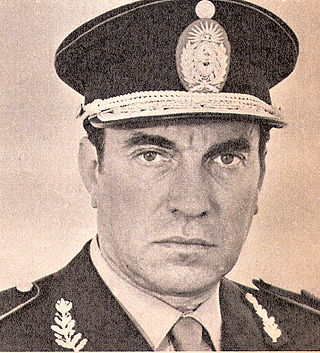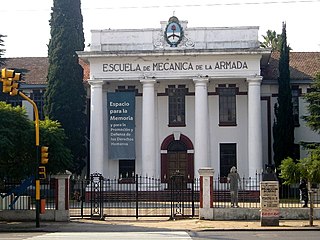Related Research Articles

Jorge Rafael Videla was an Argentine military officer and dictator who was the 47th President of Argentina and as well as the 1st President of the National Reorganisation Process from 1976 to 1981. His rule, which was during the time of Operation Condor, was among the most infamous in Latin America during the Cold War due to its high level of human rights abuses and severe economic mismanagement.

Reynaldo Benito Antonio Bignone was an Argentine general who served as President of Argentina from 1 July 1982 to 10 December 1983, the last president to serve under the military dictatorship. In 2010, he was sentenced to 25 years in prison for his role in the kidnapping, torture, and murder of persons suspected of opposing the government during the Dirty War.

The People's Revolutionary Army was the military branch of the communist Workers' Revolutionary Party in Argentina.

The Argentine Army is the land force branch of the Armed Forces of the Argentine Republic and the senior military service of Argentina. Under the Argentine Constitution, the president of Argentina is the commander-in-chief of the Armed Forces, exercising his or her command authority through the Minister of Defense.

The Rosariazo was a protest movement that consisted in demonstrations and strikes, in Rosario, province of Santa Fe, Argentina, between May and September 1969, during the military dictatorial rule of de facto President General Juan Carlos Onganía. The Rosariazo was caused by events in other parts of Argentina, and in turn triggered similar protests itself.

The following is an alphabetical list of topics related to the Argentina.

Osvaldo Bayer was an Argentine writer and journalist. He lived in Buenos Aires. In 1974, during the presidency of Isabel Perón, he went into exile, residing in Linz am Rhein, Germany, throughout the National Reorganization Process dictatorship (1976–1983).

Eustoquio Antonio Díaz Vélez was an Argentine military officer who fought against the British invasions of the Río de la Plata, participated in the May Revolution, in the war of independence and in the Argentine civil wars.

Mario Benjamin Menéndez was the Argentine governor of the Falklands during the 1982 Argentine occupation of the islands. He also served in the Argentine Army. Menéndez surrendered Argentine forces to Britain during the Falklands War.

Antonio Domingo Bussi was an army general during the military dictatorship in Argentina and a politician prominent in the recent history of Tucumán Province, Argentina. He was tried and convicted for crimes against humanity.

The Battle of Quebracho Herrado, fought on 28 November 1840 in the east of Córdoba Province, Argentina, was a victory for the Argentine federal army, led by former Uruguayan president, Brigadier Manuel Oribe over the Unitarian army led by Brigadier Juan Lavalle, during the Argentine Civil Wars.
The Battle of Rodeo del Medio, fought in Mendoza Province, Argentina on 24 September 1841, took place between the Federalist army of Ángel Pacheco and the Unitarian army of Gregorio Aráoz de Lamadrid during the Argentine Civil Wars. The consequences of the Federalist victory would last for a decade.

Héctor Ríos Ereñú was an Argentine military officer.

Ángel Guastella was an Argentine rugby union footballer and coach. He played as fly-half.
The Army General Staff is the supreme staff of the Argentine Army. It is based at the Libertador Building, Buenos Aires. The current chief is the brigadier general Carlos Alberto Presti.

Argentino del Valle Larrabure was an Argentine military officer.

The Battle of Peralejo was a military confrontation between Cuban independence rebels, under the command of Major General Antonio Maceo against the forces of the Spanish Army, under the command of Captain General Arsenio Martínez Campos, which was part of Maceo's First Eastern Campaign during the Cuban War of Independence.

Santiago Omar Riveros was an Argentinian military officer who served in the Argentine Army, in which he bore the rank of divisional general and between 1976 and 1978 held the post of Commander of Military Institutes during Argentina's so-called Dirty War in the 1970s and 1980s, waged by the self-styled "National Reorganization Process", which was in fact a military dictatorship. Riveros played a prominent role during the dictatorship's repression, for which he later faced proceedings in which he was found guilty and sentenced for crimes against humanity. At the time of his death at the age of 100, Riveros was still serving his sentence at his home.
Toribio Gragera de Vargas y Argüello, 3rd Count of Torre del Fresno (1756–1808) was a Spanish field marshal, military governor and captain general of Extremadura.

The clandestine detention, torture and extermination centers, also called, were secret facilities used by the Armed, Security and Police Forces of Argentina to torture, interrogate, rape, illegally detain and murder people. The first ones were installed in 1975, during the constitutional government of María Estela Martínez de Perón. Their number and use became generalized after the coup d'état of March 24, 1976, when the National Reorganization Process took power, to execute the systematic plan of enforced disappearance of people within the framework of State terrorism. With the fall of the dictatorship and the assumption of the democratic government of Raúl Alfonsín on December 10, 1983, the CCDs ceased to function, although there is evidence that some of them continued to operate during the first months of 1984.
References
https://web.archive.org/web/20200418104438/https://www.sports-reference.com/olympics/athletes/al/ernesto-alais-1.html https://www.lanacion.com.ar/politica/murio-el-general-ernesto-arturo-alais-nid1867953/ https://www.infobae.com/2016/02/04/1787681-murio-el-general-alais-el-militar-que-nunca-llego-los-tanques https://www.mpf.gov.ar/docs/Links/DDHH/lista_de_procesados_diciembre_2012.pdf http://www.radarmalvinas.com.ar/informes/info_ejercito/info%20ejercito%20I%20ct.pdf